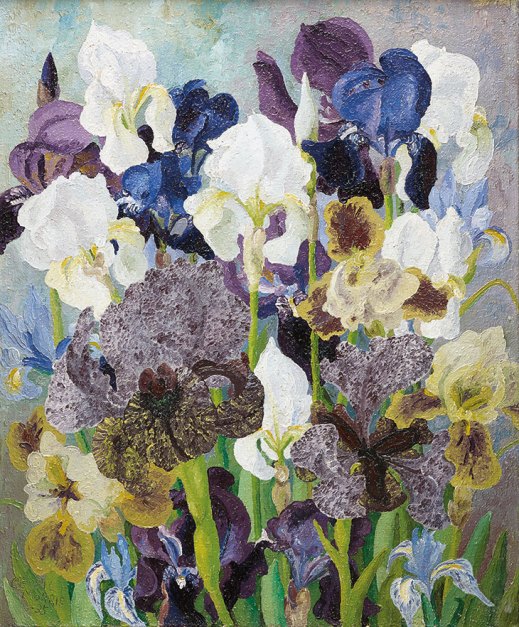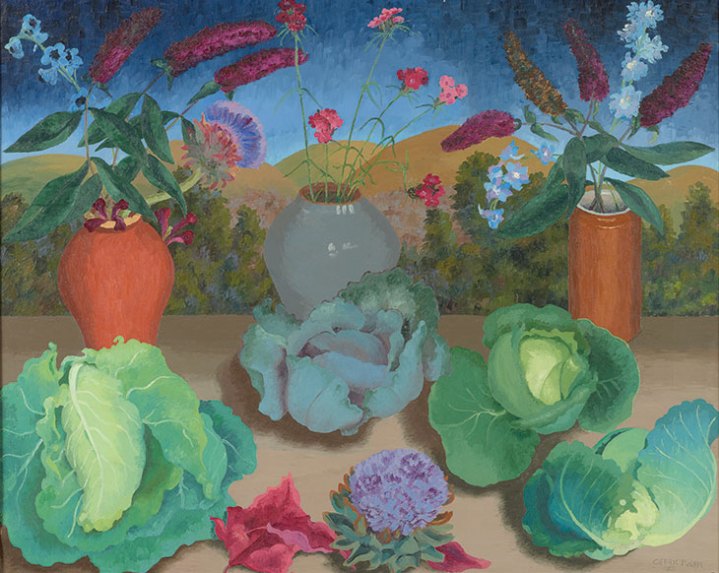At the Garden Museum, Cedric Morris’s flower paintings are shown in a single room, hung close together on walls painted a deep, earthy purple. It has the effect of a flowerbed: long-stemmed tulips, feathery irises, and bright poppies jostling for attention, their luminous colours glowing from the mulch.
Morris was a plantsman and a painter. Disillusioned with the art market and known for his charming misanthropy, he wintered on the Mediterranean and spent his summers at The Pound and then Benton End, the Suffolk homes he shared with his partner, the artist Arthur Lett-Haines. He would wake at 6am to begin weeding his garden, where he cross-bred irises and pollinated tulips and poppies by hand. When he painted, he did so indoors, mostly from memory, though occasionally a cut stem would be required to remind him of a plant’s structure.

The Orange Chair (1944), Cedric Morris. Philip Mould & Company; © the Cedric Morris Estate
The flower paintings, for which he is best known, have the precision of a naturalist; his garden, with its unorthodox mix of exotic blooms and common plants, has the palette of a painter. The exhibition brings these dual aspects together through its biographical and material focus. Alongside his vibrant paintings, Morris’s meticulous garden notebooks are displayed, teasing out the symbiosis between plants and art. The Garden Museum’s exhibition, which is concurrent with a display of Morris’s landscapes at Philip Mould & Company, seeks to restore the artist’s reputation at the forefront of the avant-garde; alongside Paul Nash, Christopher Wood and Winifred Nicholson, Morris is increasingly understood as a crucial figure in British modernism.
Morris sought to convey the ‘apprehension’ of plants, a word he used to describe their individuality and character. The flowers in his paintings are sensuous and living, revealing the intensity of his engagement with the subtleties of plant colouration and personality. Morris favoured frontal compositions, dingy backgrounds, and an evenness of light. In Paysage du Jardin No. 2 (1931), an exorbitant combination of English and exotic blooms – allium, lupin, arum lilies, foxgloves, and china aster – grows from brownish depths. In The Black Tulip (1930s) purple-grey irises, almost indistinguishable from the canvas, circle a single tall-stemmed tulip. These flowers are not ornamental, but possess a thrumming vitality. Morris takes pleasure in their foliage and dark stems, and in a sense of their movement. As the exhibition suggests, his paintings of the 1920s and ’30s correspond with a broader shift in the life sciences, away from taxonomic to ecological perspectives. In paint, Morris was developing a mode of representation that combined Expressionist and abstract elements to best portray plants in their environment.

Heralding (1959), Cedric Morris. Private collection; © the Cedric Morris Estate
Still lifes of cut flowers are as full of life as flowers in gardens. Floreat (1933) depicts blooms in vivid profusion. Passion flowers, poppies, sunflowers, hollyhocks and buddleia stems protrude from a ceramic pot set against the backdrop of Suffolk’s Stour Valley. In Heralding (1959), the curve of a blue vase echoes a river beyond, with yellow irises and allium heads dissolving into a lilac sky. Morris layered his paint thickly, dabbing it on to the canvas with the end of his brush. Maggi Hambling, a student at the East Anglia School of Painting and Drawing, which Morris founded with Lett-Haines in 1937, once observed Morris starting at the top left corner of the canvas and working his way across and downwards, methodically knitting together the paint through repeated small strokes. The effect of this curious method is nonetheless one of pleasing density, absolving his paintings from any suggestion of whimsy.

May Flowering Irises No. 2 (1935), Cedric Morris. Philip Mould & Company
By the 1950s Morris was famous for his irises, though his particularity about wild and hybrid varieties is evident earlier in the paintings. He didn’t like salmon pink – he called it ‘knicker pink’ – and looked for more unusual colours: near-black, gunmetal, paprika, bronze and gold. Each year at Benton End he planted 1,000 seedlings, cultivating technical varieties: bi-colour (those with contrasting shades on the upper and lower petals), blooms with beards and horns, and those with plicata (coloured edging to the lower petals). In paint, they’re just as audacious: streaked with blue in The Serpentine Pot (1938), or spilling over the canvas in Iris Seedlings (1943), in combinations of yellow, white, orange, burgundy and lilac. In May Flowering Irises No. 2 (1935), Morris used the end of his brush to stipple the surface of the petals, mottling yellow and purple with grey. It’s a delight that the curators have included details about his gardening, which pushes the viewer to wonder whether painting or gardening was ever foremost in Morris’s mind at any one time.

Cabbages (1953), Cedric Morris. Private collection; © the Cedric Morris Estate
The exhibition also brings to life the atmosphere and domesticity of Benton End, where from 1940 Morris and Lett-Haines housed art students (these would include Lucian Freud, who enrolled when he was 16). Students at the EASPD worked en plein air and gathered for long and lively meals cooked using fresh produce from the garden, olive oil, and garlic. Lett-Haines was a cousin of Elizabeth David, and the kitchen in Benton End was a far cry from the austerity of post-war British homes. Morris’s Mediterranean travels are reflected in his still lifes of vegetables, in tabletop bowls of pale lemons, hanging garlic, and kitchen chairs painted burnt orange. In Cabbages (1953), the vegetables are arranged with artichoke flowers and jars of buddleia stems with curling green leaves against a backdrop of rolling hills. It’s a charming record of the quotidian life of the kitchen, though Morris’s plants are never far away; in The Corduroy Trousers (1961), the artist’s gardening trousers hang on a peg on the wall, ready for him resume work in the garden.
‘Cedric Morris: Artist Plantsman – Paintings of Flowers and Gardens’ is at the Garden Museum, London, until 22 July.
From the June 2018 issue of Apollo. Preview and subscribe here.
Unlimited access from just $16 every 3 months
Subscribe to get unlimited and exclusive access to the top art stories, interviews and exhibition reviews.














![Masterpiece [Re]discovery 2022. Photo: Ben Fisher Photography, courtesy of Masterpiece London](http://www.apollo-magazine.com/wp-content/uploads/2022/07/MPL2022_4263.jpg)
It’s time for the government of London to return to its rightful home